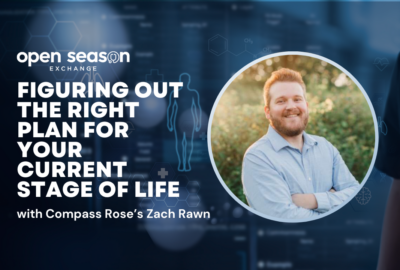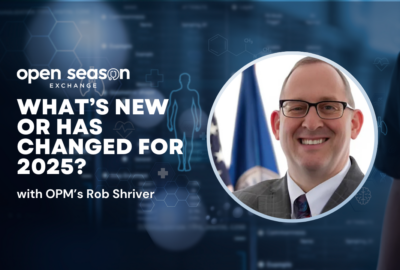2025 Open Season: Consumers’ Checkbook’s Kevin Moss on how a little planning can offset rise in premium costs
Although FEBH premium prices are up significantly on average, there are plans with lower options this year too, offers the Consumers’ Checkbook benefits exper...
Don’t despair over the fact that Federal Employee Health Benefits insurance policy premiums will jump an average of 13.5% for 2025. The crucial word is “average.” With a little research and assessment of individual situations, federal employees stand a good chance of doing better than that.
In fact, according to benefits expert Kevin Moss, premiums for 26 plans will drop next year. Premiums will stay put for about a half dozen plans, and they’ll rise well below the average for 69 plans.
Moss, the director of marketing and fundraising for the nonprofit Consumers’ Checkbook, is also a walking encyclopedia of the FEHBP. Speaking during Federal News Network’s 2025 Open Season Exchange, Moss also noted that 42 plans’ premiums will rise more than the average.
Among them: Blue Cross Standard and Blue Cross Basic, which enroll about two-thirds of federal employees and annuitants.
“So a majority of federal employees are going to be paying much higher premiums,” Moss said, “and you’ll just need to check to see how your plan as changed.”
That’s a critical point, Moss said. Feds should research not just prices change, but any differences in a plan’s specific offerings as well. He pointed to one plan, an HMO (health maintenance organization) offered in the Midwest, that will raise its premiums by 66%. While that likely rules it out for many plan holders, it might be ideal for others, he said.
“If you’re in that plan, I would ask if there something in that plan that you can’t get from any other plan,” Moss said.
How to pick your FEHB plan
Moss said that in choosing in plan, keep in mind that the premium is only one component in the total cost. Total cost is “the premium plus what you’re going to have to pay out of pocket” when receiving services, he noted.
That also includes the price of adding a spouse or dependents to your plan, co-pays for inpatient and outpatient hospital visits or specialists and brand name drugs, Moss said. Don’t overlook the out-of-pocket portions of unlikely, but expensive, catastrophic care needs, he added.
Fortunately, information about total plan costs is easy to find. Just go to Section 2 of each plan’s official brochure. The Office Personnel Management makes all the FEHB plan brochures available online.
“In that section, they will name every significant change that’s happening,” Moss said. “They will tell you if a benefit, co-pay or a co-insurance amount is increasing. They will tell you if there’s a new benefit that’s never been offered. They will tell you if there’s a new preauthorization requirement for a benefit.”
Even longstanding plans often make changes in coverage and benefits, he said. “Some are not that important, but some could be really important for you.”
Essentially, someone can find out how closely the plan they have for 2024 will match what that plan offers for 2025, Moss said.
At the same time, everyone should evaluate how they plan to use the plan. Nothing in life is certain, but in general people know their own health conditions, which services (with co-pays) they are likely to use or not use, the frequency of illnesses and other factors affecting how they will interact with a plan.
For some, Moss said, a high-deductible health plan (HDHP) might be most advantageous.
“Maybe you get sick once or twice a year,” he said. “You may go to your doctor, you may go to urgent care, and maybe you have a couple of other things in low-cost scenarios like that.” HDHPs, he said, generally have lower premiums than the popular PPO (preferred provider organization) plans.
Moss noted that many HDHP’s contribute a portion of your premium in health savings accounts, which you can in turn use for out-of-pocket health expenses.
“If you are that healthy person that doesn’t have a lot of health care needs,” he said, “or maybe you’re a younger federal employee, the high deductible health plan with a Health Savings Account probably is the right plan for you.”
Flexibility of FSAs
Flexible spending accounts, known as FSAs, can in some cases offset the premium increases for next year. Yet, Moss said, 80% of active federal employees don’t have FSAs.
Basically, the FSAFEDS program lets employees contribute up to $3,200, pre-tax, into accounts available to pay for qualified health care expenses. FSAs are mostly use it or lose it, but you can roll over $640 into the coming year’s plan.
“You definitely have to do a little bit of budgeting,” Moss said. “You don’t want to put too much money in there if you don’t think you’re going to use it.” If uncertain, he added, contribute the minimum so that any amount unused will roll over.
Moss advised everyone to sign up for an FSA because “almost all active federal employees are going to have some out-of-pocket health care expenses.” He named dental, vision and emergency care services that often come with out-of-pocket expenses. And an FSA can be used for co-pays.
Although the FSAFEDS program briefly closed earlier this year because of fraud concerns, it reopened in August with new safeguards, Moss said. Plus, the program is easy to use. It features paperless reimbursement and online tools to let plan holders choose the expenses for which to apply their accounts.
“It’s never been easier to use the FSA, and I think it’s the one tool that you have to combat these higher premium prices,” he said.
Specialized coverage
Many younger feds were happy when, in 2024, the Office of Personnel Management required FEHB plans to offer treatments for infertility. Specifically, they must cover artificial insemination procedures and drugs connected to in-vitro fertilization (IVF) for up to three cycles.
Moss said that coverage leaves out the bulk of infertility treatment costs. Blue Cross Standard last year offered a nationwide benefit of $25,000 per year toward IVF. The plan didn’t count the drug costs against that total, but it still required a member cost share.
This year, Moss said, GEHA High has become a second choice of plans offering the same benefit nationally. Plus, several local HMOs have started offering IVF coverage. Some have annual limits of less than $25,000; some have lifetime caps.
In all cases, Moss said, expect substantial out-of-pocket expenses simply because of the cost of infertility treatments. He urged people needing information about these services and what’s covered to check Section 5 of FEHB plan brochures.
At the other end of the cycle of life, retired federal employees have their own special requirements, mostly related to how FEHB plans interact with Medicare.
Of particular concern is Medicare Part D, the drug benefit section. For 2025, Part D plans have a $2,000 limit on out-of-pocket expenses.
“For any federal annuitants that have significant prescription drug costs, Part D could be a huge way to save money next year,” Moss said.
For 2024, 17 FEHB plans offered Part D coverage, for which annuitants could opt in or out. Those that opted out of Part D “will have to proactively opt in this year” during Open Season, Moss said.
Annuitants with either Medicare Part A or both parts A and B are automatically enrolled in Part D.
“Your carrier will notify you that you’ve been auto-enrolled in Part D, and during Open Season, you have a choice,” Moss said. Either stick with Part D or opt out and go with the drug coverage offered by the FEHB plan.
Moss pointed out that to get OPM approval, an insurer’s Part D plan has to offer equal or better coverage than what Medicare offers.
“That means the same drugs that you had access to from the FEHB plan must be on that part D formulary, and the member cost share has to be as good,” he said. “But in many cases, you could actually see prices lower in your Part D plan. That, in combination with the $2,000 out-of-pocket, I think for most federal annuitants this will be something that they will want to keep next year.”
Beyond Part D
An added benefit of FEHB plans not available in the commercial market is coverage of at least one weight loss drug, Moss said. Medicare Part D plans and commercial drug plans cover such drugs only when prescribed for their primary applications, such as diabetes or heart disease.
In short, Moss advised, think carefully about the best source for Part D — through Medicare itself or through the FEHB plan.
Retirees or those about to retire often have questions about other elements of Medicare, namely Part B. That’s where the Medicare Advantage plans come in. Look for plans that offer some reimbursement for portions of Part B premiums, Moss said. Examples include United Healthcare Medicare Advantage, GEHA High and Standard plans and Aetna Advantage.
These plans also “zero out all out-of-pocket health care expenses except for prescription drugs,” Moss said. “What you pay the doctor, the hospital, the acupuncturist or the chiropractor, in all three of those plans, it’s zero dollars out of pocket.”
These plans also have Medicare Part D “baked in so that you’re getting that $2,000 out-of-pocket prescription drug limit protection next year,” he said.
To access such plans, Moss said, people must remain in the FEHB Program and sign up for one of the companies’ plans. From within the plan portal, people then must take additional enrollment steps for their Medicare Advantage plans.
For 2025, given the premium inflation, feds and retirees alike will benefit from some research and taking stock.
“That’s the brilliance, by the way, of the FEHB Program,” Moss said. “Every year, you get this chance to make a different decision and take that inventory of your life — what you need — then find the plan that’s going to be the best fit for you.”
Discover more articles and videos now on Federal News Network’s 2025 Open Season Exchange event page.
Copyright © 2024 Federal News Network. All rights reserved. This website is not intended for users located within the European Economic Area.
Tom Temin is host of the Federal Drive and has been providing insight on federal technology and management issues for more than 30 years.
Follow @tteminWFED






